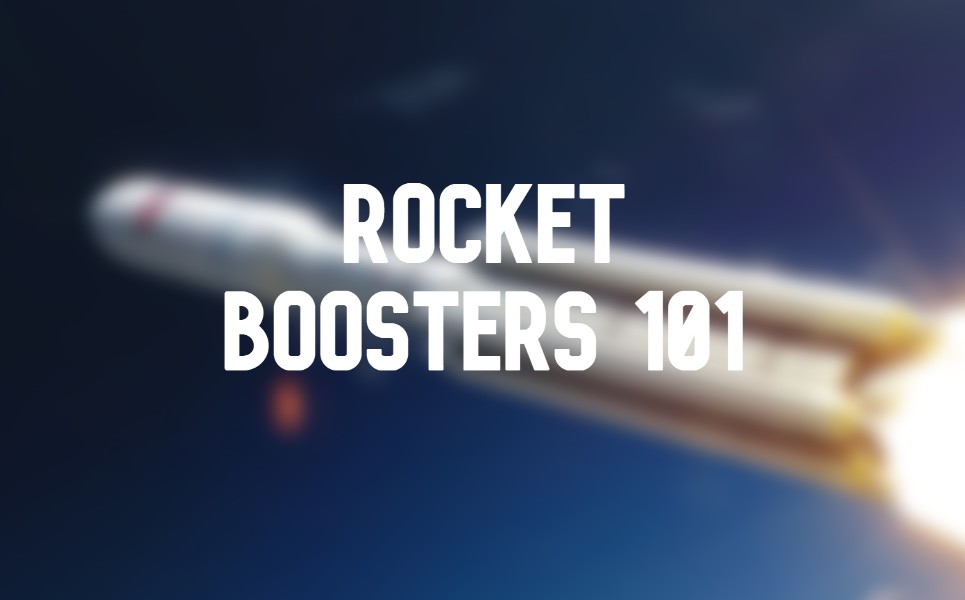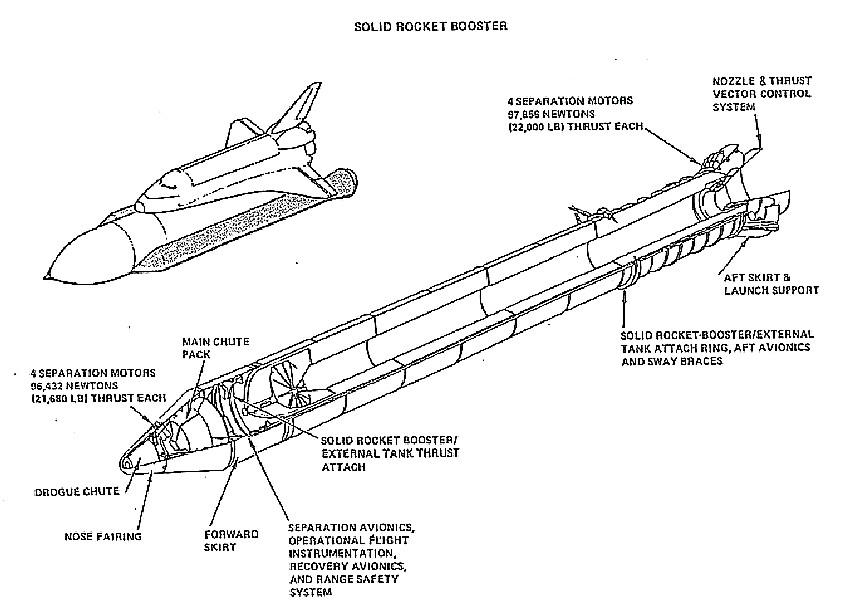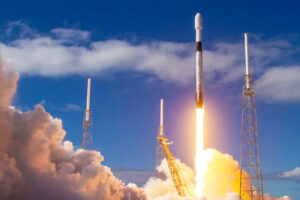Breaking gravity: everything you need to know about rocket boosters
16th Aug 2022
In 1957, humanity made a technological revolution by launching the first rocket that put something into orbit, into space. This event shocked the whole world. Today, rocket launches are made every month and have long become commonplace. And now, space engineers and amateur enthusiasts know how complicated the process of launching a rocket is and what is necessary for the multi-ton giant to take off from the ground and escape from the embrace of Earth’s gravity. This article will tell you what a rocket booster is, what is it for, what types of rocket boosters there are, and how they work.
What is the booster on a rocket?
A rocket booster is either used in the first stage of a multi-stage launch vehicle or else a side shorter-burning rocket used in parallel with a longer-burning sustainer stage to boost the space vehicle’s power and payload capability at the initial phase of the flight. The upper stage, which is used to launch a payload into a target orbit or interplanetary trajectory, can be called an orbital rocket booster.
Depending on the fuel type used, they can be solid or liquid. Let’s take a look at their differences.
What is a solid rocket booster?
A solid rocket booster (SRB) is a launcher that combines a solid propellant engine and a fuel tank in one package. The high thrust but low specific impulse makes it useless in space, as it consumes fuel very quickly (on average in 2 minutes) and is not designed to be repeatedly ignited. Once activated, the solid booster cannot be turned off or adjusted and will operate at maximum thrust until the fuel burns out. That is why it is most often used as a side booster in the rockets’ first stages, before the ignition of liquid rocket engines (a striking example is the Space Shuttle). The exception is the solid upper stage, which is specially designed for a single activation to deploy the payload into orbit.

Notably, the history of solid rocket speed boosters began long before rocket launches. They were first used in aviation in the 1930s. This was done to reduce the runway distance and ensure the takeoff of overloaded aircraft. The first serial system of 36 solid-propellant boosters was developed in the USA in 1940 and was called “JATO” (Jet Assisted Take Off). It served well during WWII, allowing to increase traction characteristics of bombers. With the improvement of turbojet engines and the advent of afterburners, the need for rocket boosters in aviation has disappeared.
What fuel is used in a solid rocket booster?
SRBs use a mixture of ammonium perchlorate (oxidizer), aluminium (fuel), and their binder component, polybutadiene (HTPB). The side boosters of the Space Shuttle, Titan, and Delta rockets used this type of fuel; today, it powers the Ariane 5, Atlas V, Delta IV, and PSLV boosters.
Despite the high density, the ease of obtaining significant thrust, and the simplicity of the solid rocket booster engine design, mixed fuel requires a high precision of production and handling since it carries a high risk of accidental ignition.
The history of astronautics still remembers the Challenger shuttle disaster that shook the world on 28th January 1986. At 73 seconds into the flight, the fuel tank exploded, which led to the destruction of the ship and the death of all seven crew members. The accident was caused by damage to the sealing ring of the right solid fuel booster at launch.
After improving the technology, solid-fuel boosters took the shuttles into space 110 more times and with them over 350 astronauts. In other words, more than half of all space flight participants reached space using solid rocket boosters. So if the technology works, why abandon it?
NASA SLS solid rocket booster

In 2011, immediately after the shutdown of the Space Shuttle program, NASA announced the start of the development of a new Space Launch System vehicle, which was supposed to take the best from the shuttles and surpass them. Today, it is known that SLS will use not four but 5-segment solid propellant boosters with PBAN (polybutadiene acrylonitrile) propellant instead of HTPB, which is less toxic and cheaper to manufacture.
These and other improvements (25% more fuel supply, improved avionics) make the SLS booster the most powerful solid booster ever built for spaceflight and according to NASA, the best option for returning humanity to the Moon. But there is a serious competitor that casts doubt on this statement.
Liquid rocket booster vs solid: pros and cons
The path to space was paved with Liquid rocket engines. With their help, the first artificial Earth satellite and the first cosmonaut Yuri Gagarin were sent into space. These engines were installed on what is still the most powerful Saturn booster rocket worldwide, which sent Neil Armstrong and Buzz Aldrin to the Moon. For decades, Liquid engines have been launching the Russian booster rocket Soyuz, the Chinese booster rocket “Long March,” the American Delta, etc., into orbit. New aerospace companies and private space giants SpaceX and Blue Origin are also betting on liquid engines. Let’s see what makes them so good.
Safety
A liquid rocket engine uses liquid propellant and oxidizer (most often LOX/Kerosene), so it can be throttled, turned on repeatedly, and also safely turned off in an emergency, which is very important for the safety of crewed flights. If there had been a liquid rocket booster on the Challenger, the tragedy would not have happened. But the history is already written.
Small size
The compact dimensions make it easy to transport liquid engines and pack them tightly at the end of the stage, so the side layout of the liquid rocket booster is found mainly on rockets with the ‘Heavy’ prefix.
Manned Flight Comfort
At a press conference for the Crew Dragon team immediately after the spacecraft docked with the ISS, astronaut Bob Behnken noted how smoothly the Falcon Heavy flew during the first minutes of the flight compared to the Shuttle. Indeed, the operation of solid fuel boosters stroll shakes the vehicle. Broadcasts from the shuttle cabin show how the crew shakes in their seats during launch, but as soon as the orbiter’s liquid engines turn on, the shaking stops.
Reusability
Due to the ability to repeatedly turn on the Liquid first stage engines, it is easier to return to Earth using a jet landing, which means that the stage will receive less damage than with an uncontrolled free fall. The less damage there is, the higher the chances for recovery and the lower its cost. SpaceX learned how to land the Falcon’s first stage on a specialized platform, fine tuning the procedure took several attempts. You can see some in the video below.
But the New Zealand aerospace company Rocket Lab was more fortunate.
However, no matter the undeniable advantages of the LRB, there is a downside to operational complexity. Fuelling a rocket requires a serious ground infrastructure: storage facilities for fuel, fuel supply systems, etc. All these technological operations complicate preparations for launch, which take a lot of time. Compared to this, SRB only needs to be attached to the rocket before launch, and the launch procedure is reduced to simply starting the igniter. And yet, in the comparison of Solid rocket booster vs liquid, the latter wins both when it comes to quality and quantity.
UK rocket boosters: former and future
The British aerospace industry has experience with both types of boosters. In the first British Black Arrow rocket, the first and second stages were equipped with Gamma propulsion liquid engines powered by a hydrogen peroxide/kerosene fuel pair, and the third stage was powered by a Waxwing solid propellant engine. Its running time in a vacuum was only 55 seconds, but this was enough to successfully launch the British Prospero communication technology demonstration satellite to LEO in 1971.
The current British launch vehicles Orbex Prime and Skyrora XL rely exclusively on liquid boosters. And they are significantly different from most engines used in other rockets. The main advantages of the new British booster rockets are compact 3D printed engines, low-carbon fuel, and reusability. Orbex Prime and Skyrora XL are still in the testing phases, but next year, and perhaps even at the end of this one, we may see them in action.
The future is bright
The 21st century opens up new opportunities in space exploration. Now we can afford cheap satellite launches, space tourism, a return to the Moon, and even the prospect of colonising Mars. However, it should be understood that chemical-fuelled rockets, whether liquid or solid, have already reached their limit in terms of capabilities; to go further, humanity needs new rocket boosters — ionic, plasma, or thermonuclear. But that’s a story for another day.
FAQ about rocket boosters to sum it up
Why do rockets need boosters?
Boosters are needed to boost the space vehicle’s tractive power and payload capability at the initial phase of the flight or for payload insertion into target orbits or trajectories.
What are rocket boosters made of?
The same materials are used in the production of rocket boosters as for other parts of the rocket. Most often, it is an alloy of aluminium and lithium, iron, titanium alloy, or composites.
How many boosters does a space rocket have?
That depends on the type of booster. If we talk about side boosters, two or more. If the booster performs the functions of the first stage or upper stage, then, as a rule, there is only one.
Do rocket boosters fall back to Earth?
Side booster or first stage usually shoots back from the rocket after burning and falls to the Earth, but the orbital rocket booster (upper stage) can be transferred to Graveyard orbit.
Does NASA recover the booster rockets?
Yes, but mainly liquid boosters. The only reusable SRB was used on the Shuttles. After detaching from the orbiter at an altitude of about 45 km, the boosters parachuted into the ocean, after which they were caught, repaired, refuelled, and reused up to ten times. Of the 270 Shuttle boosters, all but four were restored (three were lost due to a malfunction of the parachute system, one during the Challenger disaster).
How much do rocket boosters cost?
Space agencies and companies usually do not disclose this information. The exception is the Space Shuttle program: out of the $49 billion spent on creating the first Shuttle, $2.5 billion (5%) was spent on rocket boosters (figures adjusted for inflation as of 2021).






Thank you for your comment! It will be visible on the site after moderation.